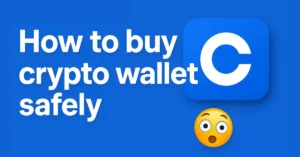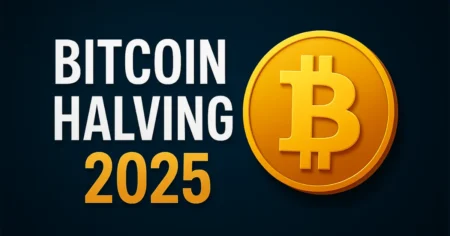Introduction
“10 Crypto Terms Every Beginner Must Know” If you’re just getting started with cryptocurrency, all the new terms and tech jargon can feel a bit overwhelming. You might have heard words like blockchain, wallet, or token but what do they actually mean?
Whether you’re thinking of investing in crypto or just want to understand how it works, learning the basic terms is the first step. That’s exactly why we created this beginner-friendly guide. At Coinsify, we believe that crypto knowledge should be simple, clear, and easy to access for everyone.
In this post, we’ll break down 10 important crypto terms every beginner should know. By the end, you’ll have a strong foundation to start exploring the world of digital currencies with confidence.
Why Understanding Crypto Terms Is Important
Before you jump into buying or trading digital assets, it’s essential to understand the basic language of cryptocurrency. Here’s why learning these key crypto terms matters especially for beginners:

Helps You Avoid Costly Mistakes
- Knowing the difference between a wallet and an exchange can help you store your crypto securely.
- Understanding private keys prevents you from accidentally giving someone full access to your funds.
Builds Confidence in Your Decisions
- When you know what terms like blockchain or gas fees mean, you can make smarter and more confident choices.
- It allows you to follow news, trends, and updates without feeling lost.
Keeps You Safe from Scams
- Many scams target beginners who don’t fully understand how crypto works.
- Learning about wallet addresses and how to use them can help protect your assets.
Makes Communication Easier
- If you’re part of any crypto community online or offline you’ll need to understand the lingo to follow conversations.
- It’s also useful when reading articles, watching tutorials, or talking to experts.
Prepares You for Smarter Investing
- Understanding terms like altcoins or HODL helps you think long-term and make better investment strategies.
- You’ll be able to research coins on platforms like Coinsify more effectively.
10 Crypto Terms Every Beginner Must Know (Step-by-Step Guide)
Getting started with crypto can feel confusing at first, but once you understand the key terms, everything becomes a lot easier. Here’s a simple guide to help you learn the top 10 crypto terms that every beginner should know before diving in.

Step 1: Understand What a Blockchain Is
Blockchain is the technology that powers most cryptocurrencies.
- It’s like a digital record book that stores transactions in blocks.
- Once added, these blocks can’t be changed—making blockchain secure and transparent.
- Think of it as a public ledger that no one can secretly edit.
Step 2: Learn the Meaning of Cryptocurrency
Cryptocurrency is a digital currency that works independently of banks.
- It uses cryptography for secure transactions.
- You can use it to buy goods or invest, just like traditional money.
- Examples include Bitcoin, Ethereum, and more.
Step 3: Know What a Wallet Is
- A wallet is where you keep your crypto safe.
- It stores your private and public keys, which are needed to send and receive crypto.
There are two main types:
- Hot Wallets (online, easy access)
- Cold Wallets (offline, more secure)
Step 4: Learn About Private Key and Public Key
These are two codes linked to your wallet:
- Public Key: Like your crypto “email address”—safe to share.
- Private Key: Like your password—never share it with anyone.
- You need both to send or receive crypto safely.
Step 5: Use a Crypto Exchange
- An exchange is where you can buy, sell, or trade cryptocurrencies.
- Examples: Binance, Coinbase, or Coinsify.
There are two types:
- Centralized Exchanges (CEX) – managed by companies.
- Decentralized Exchanges (DEX) – run by code, no central authority.
Step 6: Know Your Wallet Address
A wallet address is a string of numbers and letters, like this:
1BvBMSEYstWetqTFn5Au4m4GFg7xJaNVN2
- It’s what people use to send you crypto.
- Always double-check the address before sending or receiving funds.
Step 7: Understand Altcoins
Altcoin means any cryptocurrency other than Bitcoin.
- Popular altcoins include Ethereum, Solana, and Cardano.
- They often bring new features and improvements to the crypto world.
Step 8: Learn the Difference Between Coins and Tokens
- Coin: Has its own blockchain (e.g., Bitcoin on Bitcoin blockchain).
- Token: Built on another blockchain (e.g., USDT on Ethereum).
- Tokens are often used in apps, games, or smart contracts.
Step 9: Get Familiar with Gas Fees
Gas fees are the small costs you pay to complete a transaction on a blockchain.
- Mostly seen on Ethereum.
- Fees go to the miners or validators who process the transaction.
- Prices can change depending on how busy the network is.
Step 10: Know What HODL Means
HODL stands for “Hold On for Dear Life.”
- It started as a typo but became a term in the crypto community.
- It means buying crypto and keeping it long-term, no matter how the market moves.
Final Thoughts
Understanding these 10 basic crypto terms will help you take your first steps into the world of cryptocurrency with confidence. As you continue learning and exploring platforms like Coinsify, these concepts will become second nature.
Advantages and Disadvantages of Learning Crypto Terms
Before diving into crypto, it’s important to understand the common terms and concepts. But like everything else, this knowledge comes with both benefits and limitations.
Advantages
| ✅ Better Decision-Making You’ll make smarter choices when buying, selling, or holding crypto. Understanding terms like gas fees or HODL helps you manage your strategy better. |
| ✅ Increased Security Knowing what a private key is and how to use a wallet can protect your funds from theft or scams. |
| ✅ Strong Foundation for Advanced Learning Once you’re clear on the basics, it becomes much easier to understand advanced topics like NFTs, smart contracts, or DeFi. |
| ✅ Confidence While Using Platforms Whether you’re using Coinsify or another crypto exchange, knowing the terminology makes the experience smoother and less stressful. |
| ✅ Avoiding Mistakes Many beginners lose money simply due to confusion—learning these terms helps prevent those costly errors. |
Disadvantages
| ❌ Learning Curve For absolute beginners, it might take time to fully understand even basic terms. Some definitions (like blockchain or tokenomics) can be technical and require extra reading. |
| ❌ Not a Guarantee of Success Knowing the terms doesn’t mean you’ll always make a profit. The crypto market is still risky and volatile, even for experienced users. |
| ❌ Information Overload There’s a lot of crypto jargon out there, and trying to learn everything at once can feel overwhelming. |
| ❌ Changing Technology Crypto is a fast-evolving space—some terms may become outdated or change meaning over time. |
Bottom Line
While there are a few challenges in learning crypto terminology, the benefits far outweigh the downsides. It gives you the power to take control of your crypto journey safely and confidently. Start small, learn at your own pace, and explore trusted platforms like Coinsify to deepen your understanding.
Frequently Asked Questions (FAQs)
Why should I learn crypto terms before investing?
Learning crypto terms helps you understand how everything works. It keeps you safe from mistakes, scams, and confusion—especially when using platforms like Coinsify or trading online.
Is it hard to understand cryptocurrency terms?
Not really! Some terms might sound technical at first, but once you get the basic idea, it all becomes easier. Start with simple terms like wallet, blockchain, and exchange.
What’s the difference between a coin and a token?
A coin runs on its own blockchain (like Bitcoin or Ethereum).
A token is built on another blockchain (like USDT on Ethereum).
Both can be used for payments, apps, or investments.
Do I need a wallet to use cryptocurrency?
Yes. A wallet stores your crypto safely. It holds your private and public keys so you can send or receive coins. You can choose online wallets (hot) or offline ones (cold) for better security.
What is a private key and why is it important?
A private key is like your crypto password. It gives access to your wallet and funds. Never share it with anyone—if someone gets it, they can take your crypto.
What does HODL mean?
HODL means to hold your crypto for a long time instead of selling quickly. It started as a funny typo but is now a common term in the crypto world.
Are gas fees always expensive?
Not always. Gas fees depend on how busy the blockchain is. On platforms like Ethereum, fees can be high during peak times. Some blockchains offer cheaper or even free transactions.
Can I lose crypto if I make a mistake?
Yes. If you send crypto to the wrong wallet address or lose your private key, your funds can be lost forever. That’s why understanding terms like wallet address and private key is so important.
How do I choose a safe crypto exchange?
Look for exchanges that are well-known, secure, and easy to use like Coinsify. Check reviews, user support, and if they follow security practices like two-factor authentication.
Where can I learn more about crypto safely?
Start with beginner-friendly guides like this one. Follow trusted blogs, videos, and platforms like Coinsify that explain crypto in simple terms.
Conclusion
Getting started with crypto doesn’t have to be confusing. By learning these 10 basic terms, you’ll feel more confident, make smarter choices, and stay safe in the crypto world. Keep exploring, stay curious, and use trusted platforms like Coinsify to grow your knowledge step by step.
Bonus Tips for Crypto Beginners

Always Double-Check Wallet Addresses
- Once a crypto transaction is sent, it can’t be reversed. Always double-check the address before sending any funds.
Start Small
- If you’re just beginning, don’t invest a large amount. Start with a small amount to learn how things work safely.
Use Two-Factor Authentication (2FA)
- Always enable 2FA on your wallet and exchange accounts for extra security.
Never Share Your Private Key
- This is your most important security code. Sharing it with anyone can result in losing all your crypto.
Stay Updated
- Crypto is always changing. Follow trusted platforms like Coinsify to stay informed about new terms, updates, and safety tips.






